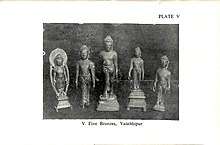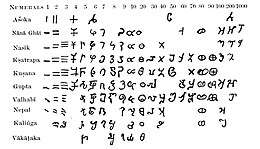Vallabhi
Vallabhi (or Valabhi or Valabhipur, modern Vala) is an ancient city located in the Saurashtra peninsula of Gujarat, near Bhavnagar in western India. It is also known as Vallabhipura, and was the capital of the ancient Gurjar Maitraka Dynasty.
Vallabhi Vala Vallabhipur | |
|---|---|
Town | |
 Vallabhi | |
| Coordinates: 21.8878°N 71.8795°E | |
| Country | India |
| State | Gujarat |
| Founded by | Maharaja Kanak sen |
| Languages | |
| • Official | Gujarati |
| Time zone | UTC+5:30 (IST) |
| Vehicle registration | gj4 |
History

Legend states that a Gurjar Kshatriya named Vijayasena founded the city around the third century. The Maitrakas ruled the peninsula and parts of southern Rajasthan from Vallabhi from the fifth to the eighth centuries. They are descendants of General Bhatarka, a military governor of the Saurashtra peninsula at the time of Gupta ruler Skandagupta (455-467).
The first two Maitraka rulers, Bhatarka and Dharasena I, only used the title of Senapati (general). The third ruler, Dronasimha(Dronasena [1]), declared himself Maharaja (literally "Great King").[2] King Guhasena came after him. Unlike his predecessors, the king stopped using the term Paramabhattaraka Padanudhyata alongside his name, a term that denotes nominal allegiance to the Gupta overlords. He was succeeded by his son Dharasena II, who used the title Mahadhiraja. The next ruler was his son, Siladitya-I Dharmaditya, who was described by a Chinese scholar and traveller Xuanzang as a "monarch of great administrative ability and of rare kindness and compassion". Siladitya I was succeeded by his younger brother Kharagraha I.[3][4][5]
During the time of Kharagraha I, a virdi copperplate grant was found from 616 CE that shows that his territories included Ujjain. During the reign of the next ruler, his son Dharasena III, north Gujarat was assimilated into the kingdom. Dharasena II was succeeded by another son of Kharagraha I, Dhruvasena II, Baladitya. He married the daughter of Harshavardhana and their son Dharasena IV assumed the imperial titles of Paramabhattaraka Mahrajadhiraja Parameshvara Chakravartin and Sanskrit poet Bhatti was his court poet. The next powerful ruler of this dynasty was Siladitya III. After him, Siladitya V ruled, and it is suspected that during his reign, there was an Arab Invasion. The last known ruler of the dynasty was Siladitya VII.[2][3]
The Maitrakas were under the rule of Harsha in the mid-seventh century but retained local autonomy. They regained independence after Harsha's death.
The rule of the Maitrakas is believed to have ended during the second or third quarter of the eighth century when the Arabs invaded.[6][7]
Vallabhi was a noted center of the Jains. It was here that the Vallabhi councils of the Jains produced the religious canon (Jain Agams) in writing under the leadership of the all Jain Acharya Shraman Devardhigani along with other 500 Jain Acharyas. The idols of representing each of them is present in the basement of the Jain temple.
However, when the Chinese traveller Xuanzang visited Vallabhi during the second quarter of 7th century, he found its ruler to be a Buddhist follower. When Yijing, another Chinese traveller, visited Vallabhi in the last quarter of 7th century, he found the city as a great centre of learning Jainism along with Buddhism. Gunamati and Sthiramati are stated to be two famous Buddhist scholars of Vallabhi at the middle of seventh century.
Valabhi inscriptions

Religious inscriptions are known from Valhabi, which were dedicated to the Brahmans as well as the Buddhist and Jains.[8] The Indologist Sylvain Lévi wrote an article entitled "Les donations religieuses des rois de Valhabi".[9]
The numerals used in the Valhabi inscriptions and on their coins, dated to circa 600CE, are often mentioned as an intermediary step in the evolution of Hindu-Arabic numerals.[10]
See also
References
- https://books.google.com.bd/books?id=dUZKAAAAcAAJ&pg=PA1553&lpg=PA1553&dq=dronasena&source=bl&ots=LoPMEw5_yt&sig=ACfU3U1gY_wY3T3p-2Beiaqlqo4lhkgWAw&hl=bn&sa=X&ved=2ahUKEwixl6XjjPfqAhXplEsFHYuuCGs4ChDoATADegQIARAB#v=onepage&q=dronasena&f=false
- Roychaudhuri, H.C. (1972). Political History of Ancient India, University of Calcutta, Calcutta, pp.553-4
- Mahajan V.D. (1960, reprint 2007). Ancient India, S.Chand & Company, New Delhi, ISBN 81-219-0887-6, pp.594-6
- Paul Monroe's encyclopaedia of history of education. Google Books. 28 August 2014. p. 177. Retrieved 15 September 2014.
- "Hiuen Tsang's Gujarat travel: 'Valabhi was at par with Nalanda' - TOI Mobile". The Times of India Mobile Site. 14 September 2014. Retrieved 15 September 2014.
- History and Culture of Indian People, Classical age, p 150, (Ed) Dr A. D. Pusalkar, Dr R. C. Majumdar.
- Blankinship, Khalid Yahya (1994). The End of the Jihad State: The Reign of Hisham Ibn 'Abd al-Malik and the Collapse of the Umayyads. SUNY Press. pp. 187–189. ISBN 978-0-7914-1827-7. Retrieved 10 May 2015.
- "M. Sylvain Levi (Les donations religieuses des rois de Valhabi) analyse, d'après les documents de l'époque, les donations faites, du VI au VIII siècle de notre ère, par les souverains de ce petit royaume bindou ou plutôt rajpoute, en faveur des communautés brahmaniques, bouddbiques et jainas, avec un éclectisme que Tauteur rappelle n'être pas rare dans l'Inde préislamique." Revue de l'histoire des religions (in French). Presses Universitaires de France [etc.] 1896. p. 345.
- Revue de l'histoire des religions (in French). Presses Universitaires de France [etc.] 1896. p. 345.
- Smith, David Eugene; Karpinski, Louis Charles (1911). The Hindu-Arabic numerals. Boston, London, Ginn and Company. p. 25.